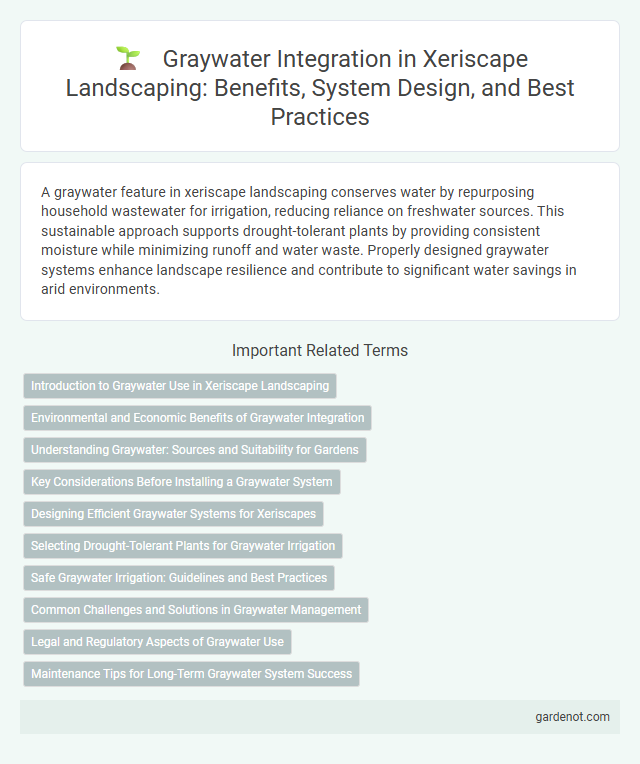A graywater feature in xeriscape landscaping conserves water by repurposing household wastewater for irrigation, reducing reliance on freshwater sources. This sustainable approach supports drought-tolerant plants by providing consistent moisture while minimizing runoff and water waste. Properly designed graywater systems enhance landscape resilience and contribute to significant water savings in arid environments.
Introduction to Graywater Use in Xeriscape Landscaping
Graywater use in xeriscape landscaping involves recycling gently used household water from sources such as sinks, showers, and laundry to irrigate drought-tolerant plants efficiently. This sustainable practice reduces potable water consumption and helps maintain healthy soil moisture levels in arid environments. Proper treatment and routing of graywater ensure plant safety while supporting water conservation goals in xeriscape design.
Environmental and Economic Benefits of Graywater Integration
Graywater integration in xeriscape landscapes significantly reduces freshwater consumption by recycling household wastewater for irrigation, conserving valuable water resources. This practice lowers water bills, offering substantial economic savings for homeowners and municipalities in arid regions. Environmentally, graywater reuse decreases strain on sewage systems and minimizes the risk of groundwater contamination, promoting sustainable urban water management.
Understanding Graywater: Sources and Suitability for Gardens
Graywater originates from household activities such as laundry, dishwashing, and bathing, excluding wastewater from toilets to prevent contamination risks. It provides a valuable irrigation source for xeriscape gardens due to its relatively low levels of contaminants and nutrients that promote plant growth without excessive irrigation demands. Proper treatment and usage of graywater ensure soil health and water conservation, making it suitable for drought-tolerant landscaping.
Key Considerations Before Installing a Graywater System
Key considerations before installing a graywater system in xeriscaping include assessing local regulations and permits to ensure compliance, evaluating water quality to prevent contamination of soil and plants, and selecting appropriate plumbing that separates graywater from blackwater. Understanding the types of graywater sources--such as laundry or bathroom sinks--and their suitability for irrigation helps optimize plant health and system efficiency. Regular maintenance plans and user education on water usage restrictions are essential to sustain the system's performance and environmental benefits.
Designing Efficient Graywater Systems for Xeriscapes
Designing efficient graywater systems for xeriscapes involves integrating low-flow plumbing fixtures that channel wastewater from showers, sinks, and laundry directly into irrigation networks, minimizing potable water use. Incorporating filtration units and directing graywater through subsurface drip irrigation ensures nutrient-rich water benefits drought-tolerant plants without surface runoff or contamination risks. Proper system sizing and compliance with local regulations optimize water conservation, enhancing xeriscape sustainability while maintaining soil health and plant vitality.
Selecting Drought-Tolerant Plants for Graywater Irrigation
Selecting drought-tolerant plants for graywater irrigation enhances water efficiency by minimizing consumption while thriving on recycled moisture. These plants, such as lavender, rosemary, and yucca, possess deep root systems and high adaptability, making them ideal for sustained growth with graywater. Proper selection reduces maintenance needs and supports sustainable xeriscape gardening by optimizing water reuse and conserving resources.
Safe Graywater Irrigation: Guidelines and Best Practices
Safe graywater irrigation involves using household wastewater from sources like sinks, showers, and laundry for landscaping while minimizing health risks and environmental impact. Essential guidelines include avoiding graywater from kitchen sinks and toilets, using low-sodium and biodegradable soaps, and directing graywater away from edible plants and potable water sources. Proper filtration, regular system maintenance, and adherence to local regulations further ensure effective, safe use of graywater in sustainable xeriscape irrigation practices.
Common Challenges and Solutions in Graywater Management
Graywater management in xeriscape gardens often faces challenges such as system clogging, improper disposal, and potential contamination from soaps and detergents. Solutions include installing filtration systems to remove debris, using biodegradable, low-sodium soaps to minimize soil and plant damage, and designing subsurface irrigation to prevent human contact and surface water pooling. Proper maintenance and regular monitoring of graywater systems help ensure efficient reuse while protecting plant health and local water quality.
Legal and Regulatory Aspects of Graywater Use
Graywater use in xeriscaping is regulated by state and local laws that specify allowable sources, treatment requirements, and application methods to ensure public health and environmental safety. Many jurisdictions require permits and adherence to plumbing codes that distinguish graywater from blackwater, emphasizing recycled water use for subsurface irrigation only. Compliance with regulations such as the EPA WaterSense program and regional water management agencies is crucial to legally implement graywater systems in drought-prone xeriscape landscapes.
Maintenance Tips for Long-Term Graywater System Success
Regular inspection of filters and pipes in a graywater system prevents clogs and ensures efficient water flow, enhancing garden irrigation. Use biodegradable, low-sodium soaps to reduce system buildup and protect plants from harmful salts. Schedule seasonal flushing of the system to remove accumulated debris and promote long-term operation.
Graywater feature Infographic

 gardenot.com
gardenot.com